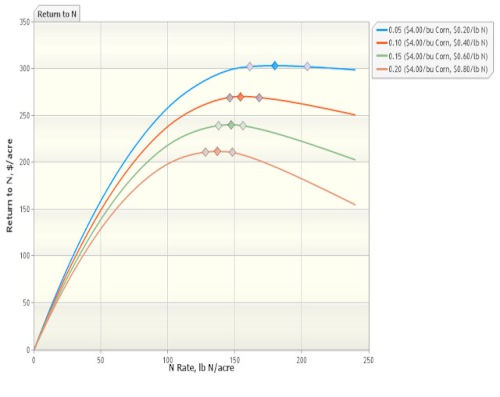By Brad Carlson
The recent increase in fertilizer prices has created quite a buzz in the agricultural community. With the price of most types of nitrogen fertilizer doubling since fall, many corn growers are questioning whether they should adjust their nitrogen fertility plans for the 2021 growing season. The short answer is: probably not.
Price ratios and the MRTN system
In 2005, most states in the Midwest, including Minnesota, adopted the Maximum Return To Nitrogen (MRTN) method of determining appropriate N rates for corn. At that time there was a significant increase in fertilizer prices and many farmers were asking whether the guidelines should be modified to reflect increased N fertilizer costs.
One of the nice things about the MRTN rate calculator is that it is adaptable to changes in prices by using a price ratio. The price ratio is a simple calculation of the current cost of N fertilizer (per pound) divided by the price of corn. For example, if N is $0.25/pound and corn is $2.50/bushel the price ratio is .10. If the price of N is $0.25 and corn is $5.00 the price ratio is .05, and if N is $0.50 and the price of corn is $2.50 the ratio is .20. However, if the price of N is $0.50/pound and corn is $5.00/bushel, the price ratio is .10 meaning the rate suggestions are the same as they were at $0.25/pound of N and the corn price of $2.50.
In the figure below, there are different curves plotted to show the MRTN for various price ratios, with the overall profitability decreasing, and the steepness of the curve increasing as the ratio increases. At the time that the MRTN system was adopted, it was thought that the various price ratios would be used periodically as the price of N fluctuated, but a price ratio of around .10 has prevailed most of the time since 2005.

Current N fertilizer prices
A fertilizer retailer late last week gave me a price quote of $770/ton for anhydrous ammonia, which is 82% nitrogen, translating to about $0.47 per pound of nitrogen. The price of urea was about $0.58 per pound of nitrogen. The current spot price for corn at an ethanol plant in south central Minnesota is $5.35, which means the price ratio is currently .09 for anhydrous, and .11 for urea. There are always questions regarding what to use for a corn price, so for comparison, the contract price for October is $4.29, giving us a price ratio of .11 for anhydrous and .135 for urea.
The bottom line is that despite the rapid increase in fertilizer prices, it is important to put the current situation in context with what has happened in the past. Examination reveals that the current ratio of N price to corn price is in line with the historical relationship. Remember, the exact best N rate for any given field cannot be known until the growing season is over due to climate and other unforeseen variables. Nevertheless, if you are following the guidelines for the .10 price ratio, there is little justification for modifying N rates due to the recent rise in N fertilizer prices. However, if you have been applying a significantly higher N rate than our nitrogen calculator recommends, this may be a good time to dial down your N rate, save some money this growing season, and reevaluate this fall.
Source : umn.edu